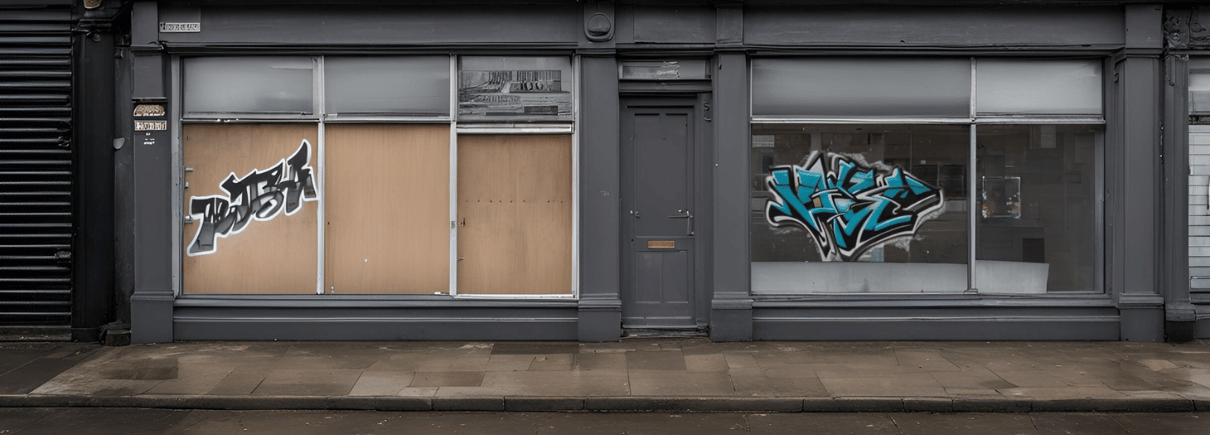A Guide To Vandalism Risks in Empty Properties
Understanding the Threat and How to Protect Your Investment
The crime of vandalism poses a significant threat to empty properties of all kinds, bringing potential financial and legal challenges that can be difficult for property owners to manage. Left unaddressed, vandalism clearly damages the property, which can be costly enough but also leads to a drop in a property’s rentable value, often means a rise in insurance premiums, and leaves the door open for potential legal disputes. Understanding these risks and implementing proactive protection strategies is essential for commercial property owners to safeguard their assets during unoccupancy.
Our latest blog explores the nature of vandalism in vacant properties, the factors contributing to its prevalence, and actionable steps you can take towards protecting vacant properties.
Understanding Vandalism & Security for Empty Buildings
In the context of empty properties, vandalism typically refers to the intentional destruction, defacement, or theft of property elements. This malicious and antisocial behaviour can vary significantly in severity and form, ranging from graffiti on external walls and the theft of minor fixtures to major structural damage and arson.
Some common forms of vandalism that vacant properties are susceptible to include:
Graffiti & Defacement: Vandals often leave graffiti or other forms of defacement by spray paint or other materials. Any defacement without permission, as opposed to street or graffiti art, is a serious crime, and associated repair and cleaning costs can be significant.
Property Damage: This can include smashed windows, broken doors, or damaged walls, which can create further vulnerabilities and require prompt repair.
Theft of Fixtures: Empty properties are often targeted for valuable fixtures like copper piping, electrical wiring, HVAC units and more.
Arson: In extreme cases, empty properties may become targets for deliberate fire-setting, leading to extensive fire damage and even risk to life.
Each form of vandalism brings unique challenges and costs, making it crucial for property owners to understand and mitigate these risks. However, the nature of the crime means that one form of vandalism will make others more likely. Graffiti, for example, will identify a property as unguarded, inviting more theft and damage, and so the cycle continues.
The Scope of the Problem: Statistics on Vandalism in Empty Properties
vUnlawful occupation, or squatting, is a significant issue for commercial landlords with vacant properties. Squatters can occupy a building without the owner’s consent; in some cases, they may even acquire certain legal rights. While squatting in residential properties is a criminal offence in the UK, squatting in commercial properties falls under civil law, which means landlords have to follow specific legal processes to achieve an eviction
Over time, if squatters remain in a property undisturbed for a prolonged period, they could potentially apply for “adverse possession,” a legal process that may allow them to gain ownership rights to the property. This situation is rare but underscores the importance of regularly checking on vacant properties and taking steps to deter unauthorised access.
To protect against squatting, landlords should ensure their properties are well-secured, using measures such as robust locks, security fencing, alarm systems, and surveillance cameras. If squatters gain access through forced entry, landlords can involve the police to address the issue as a criminal matter. In situations with no evidence of forced entry or criminal damage, eviction proceedings are more challenging, often requiring the assistance of legal experts specialising in property law to navigate the eviction process.
Lack of Oversight and Maintenance
One of the primary reasons empty properties attract vandalism is the absence of regular oversight and maintenance. When a property is left vacant, it often signals to passersby that there’s nobody caring for it. Without someone actively maintaining the property, issues like overgrown lawns, broken windows, or accumulating litter become more visible and indicate that the space is unoccupied. This attracts vandals, who are more likely to damage a property where it appears they’ll be unlikely to be noticed or reported.
Regular inspections, well-maintained exteriors, and visible security measures like cameras, clear signage and robust fencing can make a property look occupied. This can help deter vandalism by suggesting a vigilant presence.
Additionally, ongoing maintenance prevents minor vandalism or criminal damage from escalating. Small signs of criminality can snowball, causing a building to appear abandoned or derelict and tempting for vandals. Evidence of an invested owner or security presence will have the opposite effect.
Vandalism Is Viewed as a Victimless Crime
Many vandals perceive acts of vandalism on empty properties as “victimless crimes.” With no one residing in or actively using a space, individuals may believe their actions aren’t directly harming anyone. This mindset is often particularly prevalent among younger individuals who may view graffiti or property damage as inconsequential or even as a form of legitimate expression. The anonymity of vandalism—especially when it involves unoccupied properties—reinforces this perception, as vandals assume they are less likely to be caught or to face repercussions.
For commercial property owners with unoccupied assets, counteracting this perception is essential. Installing visible signage that indicates security monitoring, placing cameras, and maintaining a visible presence at the property can help shift the mindset around vandalism and emphasise that, even if vacant, the property is cared for and monitored. Community outreach can also be effective; building awareness among residents and educating communities about the financial and legal impacts of vandalism on property owners can reduce the likelihood of it being viewed as a “harmless” act.
Social Issues in the Surrounding Community
Social deprivation surrounding a vacant property can significantly contribute to vandalism risks. Properties in areas with higher rates of poverty and unemployment, especially among the youth, are often more vulnerable, as local anti-social behaviour can spill over into destructive actions. Economic hardships and limited opportunities can lead to increased criminal activity, including vandalism, as people express frustration or seek an outlet.
Properties located in communities facing social issues can benefit from proactive engagement. For example, engaging with local groups, supporting neighbourhood improvement initiatives, or even participating in community projects can create goodwill and reduce the risk of vandalism. In some cases, landlords may also collaborate with local councils to increase area security measures, such as improved street lighting or regular police patrols, which can foster a safer and more connected community environment.
The Cost of Vandalism to Property Owners
The financial burden of vandalism on vacant properties can be substantial, impacting both short-term expenses and long-term profitability. Here’s a breakdown of the types of costs property owners often incur through vandalism.
Repair and Restoration Costs
The most direct cost of vandalism is the immediate requirement to repair damage. This includes graffiti removal, replacing broken windows, and restoring stolen or damaged fixtures. Such things can be expensive and time-consuming. Depending on the severity, repair costs can quickly reach thousands of pounds, significantly impacting an owner’s budget, especially if vandalism recurs.
Increased Insurance Premiums
A less direct cost of vandalism is an uplift in insurance premiums. Properties frequently targeted by vandalism are considered higher risk by insurers. Insurers may also demand enhanced security measures if issues persist or, more seriously, refuse to insure a property with an endemic problem. It’s hard to argue against the fact that vandalism leads to higher long-term costs of maintaining adequate insurance for a property.
Potential Loss of Rental Income
For rental properties, vandalism can impact rental income in two ways. First, it can delay the leasing timeline, as necessary repairs and safety improvements must be completed before a tenant can occupy the property. These delays result in lost rental income. Second, a property that has been vandalised may no longer attract premium rental rates. Owners may have to accept lower offers, reducing the property’s profitability as an asset.
Decreased Property Value
Repeated vandalism can lower a property’s sale and rental income. A perception of neglect and increased risk may deter potential future buyers. Once gained, a reputation as a vandalised property takes time and money to shake off.






